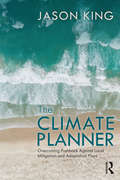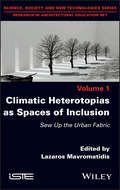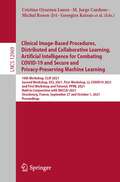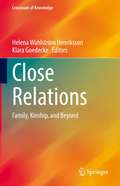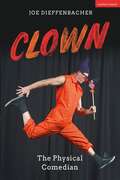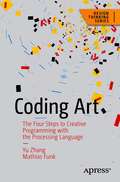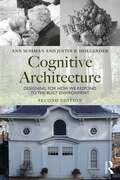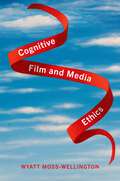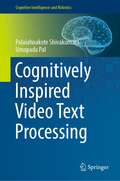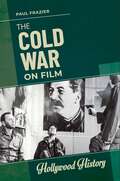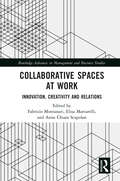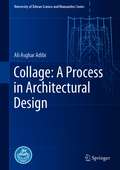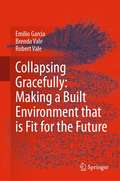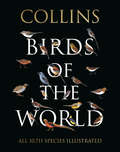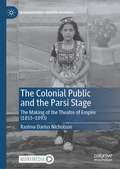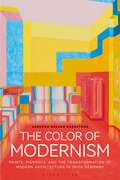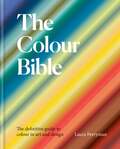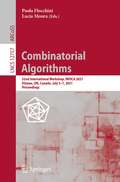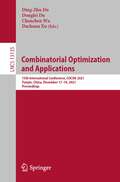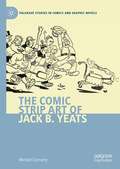- Table View
- List View
The Climate Planner: Overcoming Pushback Against Local Mitigation and Adaptation Plans
by Jason KingThe Climate Planner is about overcoming the objections to climate change mitigation and adaption that urban planners face at a local level. It shows how to draft climate plans that encounter less resistance because they involve the public, stakeholders, and decisionmakers in a way that builds trust, creates consensus, and leads to implementation. Although focused on the local level, this book discusses climate basics such as carbon dioxide levels in the atmosphere, the Intergovernmental Panel on Climate Change, the Paris Agreement of 2015, worldwide energy generation forecasts, and other items of global concern in order to familiarize urban planners and citizen planners with key concepts that they will need to know in order to be able to host climate conversations at the local level. The many case studies from around the United States of America show how communities have encountered pushback and bridged the implementation gap, the gap between plan and reality, thanks to a commitment to substantive public engagement. The book is written for urban planners, local activists, journalists, elected or appointed representatives, and the average citizen worried about climate breakdown and interested in working to reshape the built environment.
Climatic Heterotopias as Spaces of Inclusion: Sew Up the Urban Fabric
by Elias MavromatidisThis book explores, discusses and considers spatial research and its relevant pedagogic perspectives on the crossings, interactions and transformations of contemporary territorialities. The book addresses the issue of conceiving "translocal" spaces of inclusion within the framework of contemporary imposed nomadism and climate change. The concept of "climatic heterotopias" is an original, elegant concept, introduced into the pedagogy of architecture to develop teaching which aims to bring together the architectural substance and this real social need that aims to mitigate the spatial effects of climate change. Climatic Heterotopias as Spaces of Inclusion promotes the use of spatial theory and philosophy as the tools to build a strong architectural concept. The purpose of the individual contributions in the book is to introspectively explain the original concept of "climatic heterotopias". An overview is given of an innovative, penetrating pedagogic praxis intended to enhance intuition by transforming the architectural design studio into an interface where research is incorporated into everyday architectural conceptual practice, through interaction and openness. This book is a dynamic and implicit dialogue between the tutor and the learners which shapes, little by little, an alternative spatial narrative throughout architectural theory and design.
Climatic Heterotopias as Spaces of Inclusion: Sew Up the Urban Fabric
by Lazaros MavromatidisThis book explores, discusses and considers spatial research and its relevant pedagogic perspectives on the crossings, interactions and transformations of contemporary territorialities. The book addresses the issue of conceiving "translocal" spaces of inclusion within the framework of contemporary imposed nomadism and climate change. The concept of "climatic heterotopias" is an original, elegant concept, introduced into the pedagogy of architecture to develop teaching which aims to bring together the architectural substance and this real social need that aims to mitigate the spatial effects of climate change. Climatic Heterotopias as Spaces of Inclusion promotes the use of spatial theory and philosophy as the tools to build a strong architectural concept. The purpose of the individual contributions in the book is to introspectively explain the original concept of "climatic heterotopias". An overview is given of an innovative, penetrating pedagogic praxis intended to enhance intuition by transforming the architectural design studio into an interface where research is incorporated into everyday architectural conceptual practice, through interaction and openness. This book is a dynamic and implicit dialogue between the tutor and the learners which shapes, little by little, an alternative spatial narrative throughout architectural theory and design.
Clinical Image-Based Procedures, Distributed and Collaborative Learning, Artificial Intelligence for Combating COVID-19 and Secure and Privacy-Preserving Machine Learning: 10th Workshop, CLIP 2021, Second Workshop, DCL 2021, First Workshop, LL-COVID19 2021, and First Workshop and Tutorial, PPML 2021, Held in Conjunction with MICCAI 2021, Strasbourg, France, September 27 and October 1, 2021, Proceedings (Lecture Notes in Computer Science #12969)
by Cristina Oyarzun Laura M. Jorge Cardoso Michal Rosen-Zvi Georgios Kaissis Marius George Linguraru Raj Shekhar Stefan Wesarg Marius Erdt Klaus Drechsler Yufei Chen Shadi Albarqouni Spyridon Bakas Bennett Landman Nicola Rieke Holger Roth Xiaoxiao Li Daguang Xu Maria Gabrani Ender Konukoglu Michal Guindy Daniel Rueckert Alexander Ziller Dmitrii Usynin Jonathan Passerat-PalmbachThis book constitutes the refereed proceedings of the 10th International Workshop on Clinical Image-Based Procedures, CLIP 2021, Second MICCAI Workshop on Distributed and Collaborative Learning, DCL 2021, First MICCAI Workshop, LL-COVID19, First Secure and Privacy-Preserving Machine Learning for Medical Imaging Workshop and Tutorial, PPML 2021, held in conjunction with MICCAI 2021, in October 2021. The workshops were planned to take place in Strasbourg, France, but were held virtually due to the COVID-19 pandemic.CLIP 2021 accepted 9 papers from the 13 submissions received. It focuses on holistic patient models for personalized healthcare with the goal to bring basic research methods closer to the clinical practice. For DCL 2021, 4 papers from 7 submissions were accepted for publication. They deal with machine learning applied to problems where data cannot be stored in centralized databases and information privacy is a priority. LL-COVID19 2021 accepted 2 papers out of 3 submissions dealing with the use of AI models in clinical practice. And for PPML 2021, 2 papers were accepted from a total of 6 submissions, exploring the use of privacy techniques in the medical imaging community.
Close Relations: Family, Kinship, and Beyond (Crossroads of Knowledge)
by Helena Wahlström Henriksson Klara GoedeckeThis book speaks to the meanings and values that inhere in close relations, focusing on ‘family’ and ‘kinship’ but also looking beyond these categories. Multifaceted, diverse and subject to constant debate, close relations are ubiquitous in human lives on embodied as well as symbolic levels. Closely related to processes of power, legibility and recognition, close relations are surrounded by boundaries that both constrain and enable their practical, symbolical and legal formation. Carefully contextualising close relations in relation to different national contexts, but also in relation to gender, sexuality, race, religion and dis/ability, the volume points to the importance of and variations in how close relations are lived, understood and negotiated.Grounded in a number of academic areas and disciplines, ranging from legal studies, sociology and social work to literary studies and ethnology, this volume also highlights the value of using inter- and multidisciplinary scholarly approaches in research about close relations.Chapter 11 is available open access under a Creative Commons Attribution 4.0 International License via link.springer.com.
Clown: The Physical Comedian
by Joe DieffenbacherClown: The Physical Comedian is a detailed and comprehensive workbook for those interested in the art of clowning and physical theatre, including actors, directors, improvisers, stand-up comedians, circus artists, mask performers and devisers of new work. Offering an extensive and hugely diverse compilation of tried-and-tested exercises and games, the book is for students, teachers and practitioners to aid ensemble-building, character development, devising theatre, physicalising text and vocalising movement, plus creating cabaret acts, clown routines and adding physical play to scripted scenes. It offers advice on subjects such as developing presence onstage; increasing strength, flexibility and physical expression; developing partner and trio relationships; understanding the power of the mask; and working with an audience - in particular, turning a performance into a conversation with the audience and increasing the actor's ability to connect with a crowd. The exercises and teachings have been developed in classrooms, workshops and theatres all over the world and the book is packed with insights from the author, who has worked for over 35 years in a wide variety of venues, from intimate performance spaces to large-scale sports stadiums.
Coding Art: The Four Steps to Creative Programming with the Processing Language (Design Thinking)
by Yu Zhang Mathias FunkFinally, a book on creative programming, written directly for artists and designers! Rather than following a computer science curriculum, this book is aimed at creatives who are working in the intersection of design, art, and education. In this book you'll learn to apply computation into the creative process by following a four-step process, and through this, land in the cross section of coding and art, with a focus on practical examples and relevant work structures. You'll follow a real-world use case of computation art and see how it relates back to the four key pillars, and addresses potential pitfalls and challenges in the creative process. All code examples are presented in a fully integrated Processing example library, making it easy for readers to get started.This unique and finely balanced approach between skill acquisition and the creative process and development makes Coding Art a functional reference book for both creative programming and the creative process for professors and students alike.What You’ll LearnReview ideas and approaches from creative programming to different professional domainsWork with computational tools like the Processing languageUnderstand the skills needed to move from static elements to animation to interactionUse interactivity as input to bring creative concepts closer to refinement and depthSimplify and extend the design of aesthetics, rhythms, and smoothness with data structuresLeverage the diversity of art code on other platforms like the web or mobile applicationsUnderstand the end-to-end process of computation art through real world use casesStudy best practices, common pitfalls, and challenges of the creative processWho This Book Is ForThose looking to see what computation and data can do for their creative expression; learners who want to integrate computation and data into their practices in different perspectives; and those who already know how to program, seeking creativity and inspiration in the context of computation and data.
Cognitive Architecture: Designing for How We Respond to the Built Environment
by Ann Sussman Justin B HollanderIn this expanded second edition of Cognitive Architecture, the authors review new findings in psychology and neuroscience to help architects and planners better understand their clients as the sophisticated mammals they are, arriving in the world with built-in responses to the environment. Discussing key biometric tools to help designers ‘see’ subliminal human behaviors and suggesting new ways to analyze designs before they are built, this new edition brings readers up-to-date on scientific tools relevant for assessing architecture and the human experience of the built environment. The new edition includes: Over 100 full color photographs and drawings to illustrate key concepts. A new chapter on using biometrics to understand the human experience of place. A conclusion describing how the book’s propositions reframe the history of modern architecture. A compelling read for students, professionals, and the general public, Cognitive Architecture takes an inside-out approach to design, arguing that the more we understand human behavior, the better we can design and plan for it.
Cognitive Architecture: Designing for How We Respond to the Built Environment
by Ann Sussman Justin B HollanderIn this expanded second edition of Cognitive Architecture, the authors review new findings in psychology and neuroscience to help architects and planners better understand their clients as the sophisticated mammals they are, arriving in the world with built-in responses to the environment. Discussing key biometric tools to help designers ‘see’ subliminal human behaviors and suggesting new ways to analyze designs before they are built, this new edition brings readers up-to-date on scientific tools relevant for assessing architecture and the human experience of the built environment. The new edition includes: Over 100 full color photographs and drawings to illustrate key concepts. A new chapter on using biometrics to understand the human experience of place. A conclusion describing how the book’s propositions reframe the history of modern architecture. A compelling read for students, professionals, and the general public, Cognitive Architecture takes an inside-out approach to design, arguing that the more we understand human behavior, the better we can design and plan for it.
Cognitive Film and Media Ethics
by Wyatt Moss-WellingtonCognitive Film and Media Ethics provides a grounding in the use of cognitive science to address key questions in film, television and screen media ethics. This book extends past works in cognitive media studies to answer normative and ethically prescriptive questions: what could make media morally good or bad, and what, then, are the respective responsibilities of media producers and consumers? Moss-Wellington makes a primary claim that normative propositions are a kind of rigour, in that they force media theorists to draw more active ought conclusions from descriptive is arguments. Cognitive Film and Media Ethics presents the rigours of normative reasoning, cognitive science and consequentialist ethics as complementary, arguing that each seeks progressive elaboration on their own models of causality, and causal projections are crucial for any reflection on our moral responsibilities in the world. A hermeneutics of "ethical cognitivism" is applied in the latter half of the book, with essays each addressing a different case study in film, television, news and social media: cinema that sets out to inspire moral dissonance in the viewer, satirical and humorous depictions of family drama in film and television, the politics of the romantic comedy, formal aspects of screen media bullying in an era dubbed the "television renaissance," and contemporary problems in the conflation of news and social media. Cognitive Film and Media Ethics synthesises current research in social psychology, anthropology, memory studies, emotion and cognition, personality and media selection, and evolutionary biology, integrating wide-ranging concepts from the various disciplines that make up cognitive theory to provide new vantages on the applied ethics of film and screen media.
Cognitively Inspired Video Text Processing (Cognitive Intelligence and Robotics)
by Umapada Pal Palaiahnakote ShivakumaraAs technologies are fast advancing, the importance of text detection and recognition is receiving special attention from the researchers. Thus, one can see several real-time applications of video text processing which requires cognitive-based methods to find a solution. The main applications are (1) retrieving and indexing video based on semantic of the content of the video, (2) machine translation to assist foreigners, (3) assisting blind people to walk on the road freely without aid, (4) automatic vehicle driving, (5) license plate tracing to catch vehicles which violate the traffic signals, (6) monitoring the images posted on social media based on text and content of the images, (7) identifying the location based on the address of the street and shops, etc., (8) tracing players in the sports based on the jersey/bib number or text, and (9) in the same way, tracing the bib number in case of marathon and other events. For the above-mentioned applications, text detection and recognition in video and natural scene images is an integral part of the system.
The Cold War on Film (Hollywood History)
by Paul FrazierThe Cold War on Film illustrates how to use film as a teaching tool. It stands on its own as an account of both the war and the major films that have depicted it.Memories of the Cold War have often been shaped by the popular films that depict it—for example, The Manchurian Candidate, The Hunt for Red October, and Charlie Wilson's War, among others. The Cold War on Film examines how the Cold War has been portrayed through a selection of 10 iconic films that represent it through dramatization and storytelling, as opposed to through documentary footage.The book includes an introduction to the war's history and a timeline of events. Each of the 10 chapters that follow focuses on a specific Cold War film. Chapters offer a uniquely detailed level of historical context for the films, weighing their depiction of events against the historical record and evaluating how well or how poorly those films reflected the truth and shaped public memory and discourse over the war. A comprehensive annotated bibliography of print and electronic sources aids students and teachers in further research.
The Cold War on Film (Hollywood History)
by Paul FrazierThe Cold War on Film illustrates how to use film as a teaching tool. It stands on its own as an account of both the war and the major films that have depicted it.Memories of the Cold War have often been shaped by the popular films that depict it—for example, The Manchurian Candidate, The Hunt for Red October, and Charlie Wilson's War, among others. The Cold War on Film examines how the Cold War has been portrayed through a selection of 10 iconic films that represent it through dramatization and storytelling, as opposed to through documentary footage.The book includes an introduction to the war's history and a timeline of events. Each of the 10 chapters that follow focuses on a specific Cold War film. Chapters offer a uniquely detailed level of historical context for the films, weighing their depiction of events against the historical record and evaluating how well or how poorly those films reflected the truth and shaped public memory and discourse over the war. A comprehensive annotated bibliography of print and electronic sources aids students and teachers in further research.
Collaborative Spaces at Work: Innovation, Creativity and Relations (Routledge Advances in Management and Business Studies)
by Fabrizio Montanari Elisa Mattarelli Anna Chiara ScapolanCollaborative spaces are more than physical locations of work and production. They present strong identities centered on collaboration, exchange, sense of community, and co-creation, which are expected to create a physical and social atmosphere that facilitates positive social interaction, knowledge sharing, and information exchange. This book explores the complex experiences and social dynamics that emerge within and between collaborative spaces and how they impact, sometimes unexpectedly, on creativity and innovation. Collaborative Spaces at Work is timely and relevant: it will address the gap in critical understandings of the role and outcomes of collaborative spaces. Advancing the debate beyond regional development rhetoric, the book will investigate, through various empirical studies, if and how collaborative spaces do actually support innovation and the generation of new ideas, products, and processes. The book is intended as a primary reference in creativity and innovation, workspaces, knowledge and creative workers, and urban studies. Given its short chapters and strong empirical orientation, it will also appeal to policy makers interested in urban regeneration, sustaining innovation, and social and economic development, and to managers of both collaborative spaces and companies who want to foster creativity within larger organizations. It can also serve as a textbook in master’s degrees and PhD courses on innovation and creativity, public management, urban studies, management of work, and labor relations.
Collaborative Spaces at Work: Innovation, Creativity and Relations (Routledge Advances in Management and Business Studies)
by Fabrizio Montanari Elisa Mattarelli Anna Chiara ScapolanCollaborative spaces are more than physical locations of work and production. They present strong identities centered on collaboration, exchange, sense of community, and co-creation, which are expected to create a physical and social atmosphere that facilitates positive social interaction, knowledge sharing, and information exchange. This book explores the complex experiences and social dynamics that emerge within and between collaborative spaces and how they impact, sometimes unexpectedly, on creativity and innovation. Collaborative Spaces at Work is timely and relevant: it will address the gap in critical understandings of the role and outcomes of collaborative spaces. Advancing the debate beyond regional development rhetoric, the book will investigate, through various empirical studies, if and how collaborative spaces do actually support innovation and the generation of new ideas, products, and processes. The book is intended as a primary reference in creativity and innovation, workspaces, knowledge and creative workers, and urban studies. Given its short chapters and strong empirical orientation, it will also appeal to policy makers interested in urban regeneration, sustaining innovation, and social and economic development, and to managers of both collaborative spaces and companies who want to foster creativity within larger organizations. It can also serve as a textbook in master’s degrees and PhD courses on innovation and creativity, public management, urban studies, management of work, and labor relations.
Collage: A Process in Architectural Design (University of Tehran Science and Humanities Series)
by Ali Asghar AdibiThis book is about using “collage” among Iranian students in architecture studio, and in order to introduce the way these students use the technique to the English reader, we (Ali Yaser Jafari and Reihaneh Khorramrouei) have chosen this valuable book by AliAsghar Adibi to translate from Farsi to English. It provides a representative example of design through collage and culture. This book originally collected and published in three chapters: Collage history in different arts; Objectives and steps to make collage images; Two experienced examples.
Collapsing Gracefully: Making a Built Environment that is Fit for the Future
by Emilio Garcia Brenda Vale Robert ValeThis innovative book investigates the concept of collapse in terms of our built environment, exploring the future transition of modern cities towards scenarios very different from the current promises of progress and development. This is not a book about the end of the world and hopeless apocalyptic scenarios. It is about understanding change in how and where we live. Collapse is inevitable, but in the built environment collapse could imply a manageable situation, an opportunity for change or a devastating reality. Collapsing gracefully means that there might be better ways to coexist with collapse if we learn more about it and commit to rebuild our civilisations in ways that avoid its worst effects. This book uses a wide range of practical examples to study critical changes in the built environment, to contextualise and visualise what collapse looks like, to see if it is possible to buffer its effects in places already collapsing and to propose ways to develop greater resilience.The book challenges all agents and institutions in modern cities, their designers and planners as well as their residents and users to think differently about built environment so as to ease our coexistence with collapse and not contribute to its causes. .
Collins Birds of the World
by Norman Arlott Ber van Perlo Jorge R. Mata Gustavo Carrizo Aldo A. Chiappe Luis HuberFor the first time, the complete collection of the Collins Field Guides’ incredibly detailed, accurate and beautiful bird paintings has been brought together in one comprehensive volume.
The Colonial Public and the Parsi Stage: The Making of the Theatre of Empire (1853-1893) (Transnational Theatre Histories)
by Rashna Darius NicholsonThe Colonial Public and the Parsi Stage is the first comprehensive study of the Parsi theatre, colonial South and Southeast Asia’s most influential cultural phenomenon and the precursor of the Indian cinema industry. By providing extensive, unpublished information on its first actors, audiences, production methods, and plays, this book traces how the theatre—which was one of the first in the Indian subcontinent to adopt European stagecraft—transformed into a pan-Asian entertainment industry in the second half of the nineteenth century. Nicholson sheds light on the motivations that led to the development of the popular, commercial theatre movement in Asia through three areas of investigation: the vernacular public sphere, the emergence of competing visions of nationhood, and the narratological function that women served within a continually shifting socio-political order. The book will be of interest to scholars across several disciplines, including cultural history, gender studies, Victorian studies, the sociology of religion, colonialism, and theatre.
The Color of Modernism: Paints, Pigments, and the Transformation of Modern Architecture in 1920s Germany
by Deborah Ascher BarnstoneOne of the most enduring and pervasive myths about modernist architecture is that it was white-pure white walls both inside and out. Yet nothing could be further from the truth. The Color of Modernism explodes this myth of whiteness by offering a riot of color in modern architectural treatises, polemics, and buildings.Focusing on Germany in the early 20th century, one of modernism's most foundational and influential periods, it examines the different scientific and artistic color theories which were advanced by members of the German avant-garde, from Bruno Taut to Walter Gropius to Hans Scharoun. German color theory went on to have a profound influence on the modern movement, and Germany serves as the key case study for an international phenomenon which encompassed modern architects worldwide from le Corbusier and Alvar Aalto to Berthold Lubetkin and Lina Bo Bardi.Supported by accessible introductions to the development of color theory in philosophy, science and the arts, the book uses the German case to explore the new ways in which color was used in architecture and urban design, turning attention to an important yet overlooked aspect of the period. Much more than a mere correction to the historical record, the book leads the reader on an adventure into the color-filled worlds of psychology, the paranormal, theories of sensory perception, and pleasure, showing how each in turn influenced the modern movement. The Color of Modernism will fundamentally change the way the early modernist period is seen and discussed.
The Colour Bible: The definitive guide to colour in art and design
by Laura PerrymanAn essential source for graphic designers, artists, interior designers, fashion designers, illustrators and creatives of any kind who work with colour.Colour is intrinsic to the human experience; it guides us with subconscious visual cues throughout our lives. Get it right in your design or art and you can enhance mood and atmosphere, and create a desired psychological or even physiological effect. The Colour Bible is a contemporary handbook for navigating this fascinating world of colour. It dives into 100 profiles of significant colours and tracks them through their genesis, historical usage in art and design, and contemporary connotations and uses. - A potted history of each colour- Key colour associations from around the world- Contemporary connotations and brand design- Practical advice on how to use and combine colours in your work
Combinatorial Algorithms: 32nd International Workshop, IWOCA 2021, Ottawa, ON, Canada, July 5–7, 2021, Proceedings (Lecture Notes in Computer Science #12757)
by Paola Flocchini Lucia MouraThis book constitutes the proceedings of the 32nd International Workshop on Combinatorial Algorithms which was planned to take place in Ottawa, ON, Canada, in July 2021. Due to the COVID-19 pandemic the conference changed to a virtual format.The 38 full papers included in this book together with 2 invited talks were carefully reviewed and selected from 107 submissions. They focus on algorithms design for the myriad of combinatorial problems that underlie computer applications in science, engineering and business.Chapter “Minimum Eccentricity Shortest Path Problem with Respect to Structural Parameters” is available open access under a Creative Commons Attribution 4.0 International License via link.springer.com.
Combinatorial Optimization and Applications: 15th International Conference, COCOA 2021, Tianjin, China, December 17–19, 2021, Proceedings (Lecture Notes in Computer Science #13135)
by Ding-Zhu Du Donglei Du Chenchen Wu Dachuan XuThis book constitutes the refereed proceedings of the 15th Annual International Conference on Combinatorial Optimization and Applications, COCOA 2021, which took place in Tianjin, China, during December 17-19, 2021.The 55 papers presented in this volume were carefully reviewed and selected from 122 submissions. They deal with combinatorial optimization and its applications in general, focusing on algorithms design, theoretical and experimental analysis, and applied research of general algorithmic interest.
The Comic Strip Art of Jack B. Yeats (Palgrave Studies in Comics and Graphic Novels)
by Michael ConnertyThis monograph seeks to recover and assess the critically neglected comic strip work produced by the Irish painter Jack B. Yeats for various British publications, including Comic Cuts, The Funny Wonder, and Puck, between 1893 and 1917. It situates the work in relation to late-Victorian and Edwardian media, entertainment and popular culture, as well as to the evolution of the British comic during this crucial period in its development. Yeats’ recurring characters, including circus horse Signor McCoy, detective pastiche Chubblock Homes, and proto-superhero Dicky the Birdman, were once very well-known, part of a boom in cheap and widely distributed comics that Alfred Harmsworth and others published in London from 1890 onwards. The repositioning of Yeats in the context of the comics, and the acknowledgement of the very substantial corpus of graphic humour that he produced, has profound implications for our understanding of his artistic career and of his significant contribution to UK comics history. This book, which also contains many examples of the work, should therefore be of value to those interested in Comics Studies, Irish Studies, and Art History.
Common Image: Towards a Larger Than Human Communism (Image #201)
by Ingrid Hoelzl Rémi MarieWestern humanism has established a reifying and predatory relation to the world. While its collateral visual regime, the perspectival image, is still saturating our screens, this relation has reached a dead end. Rather than desperately turning towards transhumanism and geoengineering, we need to readjust our position within community Earth. Facing this predicament, Ingrid Hoelzl and Rémi Marie develop the notion of the common image - understood as a multisensory perception across species; and common ethics - a comportment that transcends species-bound ways of living. Highlighting the notion of the common as opposed to the immune, the authors ultimately advocate otherness as a common ground for a larger than human communism.
